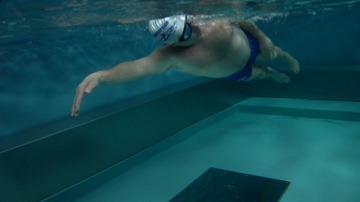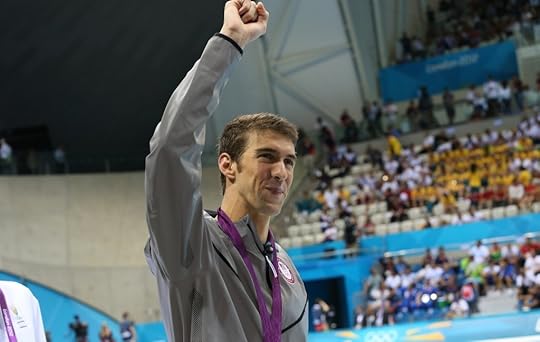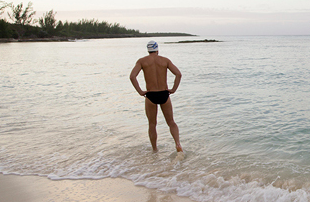Terry Laughlin's Blog, page 24
April 18, 2014
Change Your Swimming in Three Minutes, Part Two: Visualize!
In my previous installment in this three part series Change Your Swimming in Three Minutes I suggested setting aside three minutes at the beginning of practice-in most cases before you enter the pool–to calm and focus your mind. To recap, the first-stage exercise included:
Nose breathing. Mouth breathing stimulates the sympathetic nervous system, which activates when we’re under stress. Nose breathing stimulatesthe parasympathetic nervous system which is calming and therapeutic.
Slow your breathing. This relaxes you, increases breathing efficiency, and increases oxygenation at the cellular level. As an exercise, using your watch, time your normal breathing frequency for a minute. The average is about 12. Then see if you can slow breathing to 7 or fewer per minute. (Note: Inhale slowly and fully. Hold for a moment–don’t tense–then let your breath ‘fall’ out. Pause briefly moment–feeling relaxed–before inhaling again.) Sitting at my desk while writing this just now, I comfortably breathed six times in a minute. Practice this a few times a day for a break from your routine so you can easily recapture it at the pool.
Empty your mind. Train your full awareness on the breath. Let all other thoughts go. If your mind strays, bring it back.
Once you are physically relaxed, psychically calm, you’re ready to fill the mentally receptive space you’ve created with a thought o accompany your breathing . . . In this case, a stroke thought.
Choose a Focal Point with which you’re familiar from practice. With eyes closed or open (but unfocused) imagine yourself swimming. Experience the sensation as vividly as possible.
Visualization is a skill that improves with practice. The benefit of visualization is that the neural circuits that fire when you’re actually performing the action, also fire when you visualize. The advantage of visualization is that you can mentally rehearse perfection. (Read about a Harvard research study on practicing piano via visualization.)
A few suggestions for visualizing:
Head Position Visualize yourself stroking with a weightless, neutral, perfectly stable head. Visualize the feeling of connection/alignment between head and spine. Visualize the feeling of head cushioned by the water. Visualize breathing feeling the same level of support and relaxation.
Lengthening. Visualize the feeling of each arm extending weightlessly as you stroke, feeling your relaxed hand ‘carving a gentle downward arc and a light forward pull on your shoulder as you reach full extension.
Lengthen as you Breathe. Combine the two previous sensations: Feel your left arm lengthen–as described–as your head rotates with your body to the right–as described.
NOTE: If you’re new to the practice of visualization,, choose ONE sensation to visualize. In fact, use that one visualization repeatedly, for three or more practices, until you notice real improvement in your ability to maintain the visualization for 30 seconds and to feel it almost as vividly–but hopefully even better–than when actually swimming.
The post Change Your Swimming in Three Minutes, Part Two: Visualize! appeared first on Swim For Life.
The post Change Your Swimming in Three Minutes, Part Two: Visualize! appeared first on Total Immersion.
April 17, 2014
Metrics 102: Tempo
Improving your Tempo is not merely about getting your arms to spin faster – to be more complete, more adaptable swimmers we want to build a wider comfortable Tempo Range, both toward the fast and the slow directions, while protecting Stroke Length.
Practicing near your slow Tempo threshold will challenge your balance and passive streamline. Practicing near your fast Tempo Threshold will challenge your timing and control of active streamline.
Here are a couple practice suggestions for each end of your Tempo range…
**
Click here to read more of this post…
To view hundreds of articles of coaching advice and answers to swimmer’s questions on training and technique please visit Coach Mat’s Smooth Strokes blog.
The post Metrics 102: Tempo appeared first on Total Immersion.
April 15, 2014
Michael Phelps Redux
Yesterday’s news included an item that quickened the pulses of quite a few swim fans–and probably USA Swimming honcho’s too. Michael Phelps is returning to competitive swimming. Mind you, there was no mention of Rio 2016, only that he ‘ll race at an Arena Grand Prix meet in Mesa Arizona next week.
In the article Phelps is Back–and at His Age, Why Not New York Times writer Christopher Clary noted that Phelps, at 28, is younger than Lebron James, and should he swim in Rio will be only 31, younger than Roger Federer is now.
But as Clary also noted ”In the pool, he has very little, if anything, left to prove, which might not be best in a sport where the training is arduous and repetitive enough to require extreme motivation.”
Phelps earned enough from the 22 Olympic medals he already owns that–barring bad investments (he’s a part owner of Meadowbrook Aquatic Club in Baltimore, the facility where he trains) he should be able to live comfortably the rest of his days.
So what’s his motivation? I suspect it’s mainly his undimmed competitive drive. While a few additional Olympic medals would do relatively little to enhance the luster of the legacy he’s already created, it’s probably harder than he realized it would be to sit on the sidelines and watch others lead the world rankings with times he may feel he could match even without ‘arduous and repetitive training.’
If do hope that Phelps finds that motivation, and that, rather than extreme, it’s the satisfaction any of us can gain from doing something we love at the highest level possible each time we practice. If he does, the results of any races he swims will almost be besides the point.
The post Michael Phelps Redux appeared first on Swim For Life.
The post Michael Phelps Redux appeared first on Total Immersion.
April 14, 2014
Three Training Values
Speed is a product of work.
What kind of work?
Work to reduce resistance coming against us.
Work to over-power what resistance is left after Work #1.
Speed is one measurement of how well we accomplish those two forms of work. But it is not all.
Efficiency is using the minimal amount of energy to accomplish that work.
Enjoyment is the pleasurable product of the mind – the self-perpetuating positive motivation to continually work towards solving the problems presented by Speed and Efficiency.
These three together measure swimming excellence in my book.
**
Click here to read more of this post…
To view hundreds of articles of coaching advice and answers to swimmer’s questions on training and technique please visit Coach Mat’s Smooth Strokes blog.
The post Three Training Values appeared first on Total Immersion.
April 12, 2014
Stepping Stone Solutions
If we want to build a pathway that can be used by common humans we have to recognize that a stepping stone needs to be set up in a certain way for success. Those stepping stones need to be shaped within certain parameters and spaced at certain intervals in order for the general population of humans to use that pathway regularly without mishap.
Now to apply this to our swimming – whether learning to swim for the first time, or learning to break through the barriers to speed and endurance – a key to anyone’s success is about placing the right stones in the right spots – this enables the swimmer to build each necessary skill in sequence which then allows him to break through to a new level of ability and ease.
Now let’s work with this analogy a bit more to explain the TI skill training process.
**
Click here to read more of this post…
To view hundreds of articles of coaching advice and answers to swimmer’s questions on training and technique please visit Coach Mat’s Smooth Strokes blog.
The post Stepping Stone Solutions appeared first on Total Immersion.
April 10, 2014
SPL Development Process
In the first stage you are developing the ability to reach appropriate stroke length- the first goal is to simply be able to swim in our SPL Sweet Spot range. This is hard work and requires time and concentration to get there. I have outlined the process above.
If the Swimmer is currently at 22 SPL but estimates an appropriate SPL Sweet Spot of 16-18 SPL, then he needs to work his way down into that range.
**
Click here to read more of this post…
To view hundreds of articles of coaching advice and answers to swimmer’s questions on training and technique please visit Coach Mat’s Smooth Strokes blog.
The post SPL Development Process appeared first on Total Immersion.
April 8, 2014
Focus: Always a Work in Progress
In my most recent post Change Your Swimming in Three Minutes, I suggested doing a 3-minute exercise in nose-breathing and mind-clearing prior to entering the pool for practice.
I wrote that post after several days of doing that exercise as I prepared to start a session of writing. It did help center me for somewhat less distracted writing.
I must however confess that I neglected to take my own advice before swimming this morning at Bard College. Even so, I got into a pleasantly focused and relaxed state as soon as I began swimming.
In part I credit that to mental/emotional conditioning. I start every practice with at least five minutes of super relaxed swimming. But, as today’s practice showed, maintaining peak focus is always a work in progress.
For my tuneup, I swam this Pyramid set:
50+100+150+200+150+100+50.
My goal was to feel silky smooth while holding 13SPL; and maintaining my 50 pace as distance increased to 200 . . . then slightly quicken my pace—without sacrificing my consummate ease—as distances decreased again. I did just that, but felt a slight bit of strain holding 13SPL on the 200 and the 2nd 150. The extra effort was as much mental as physical—as it should be.
For my main task I did:
5 rounds of [3 x 50 + 1 x 200]
My goal was to swim quite relaxed on the 50s at 14-15 SPL, then swim ‘quick but quiet’ on the 200s at 15-16SPL and try to match the pace I swam on the 50s. The 50s were 42 sec, so I’d be aiming for 2:48.
I was sharing the lane with someone using a hurried, splashy stroke. Nothing unusual in that. But, besides the distraction, it created extra turbulence. On my first 200, I just missed the wall on a couple of my flip turns and my stroke count was a bit erratic. I could feel myself starting to struggle just a bit. My time on the first 200 was 2:55.
Though the time was 7 seconds slower than I’d been aiming for, I recalled exercise scientist Dr. Mike Joyner’s advice to focus on making a current time feel easier, rather than trying to swim faster.
I was aware of many small errors in that first 200 and knew I could correc them with better focus. As each round passed, the strength and consistency of my focus increased . . . and my times came down, even as I focused on swimming easier. On the final round I swam the 200 in 2:47 and left the pool feeling Mission Accomplished.
Friday I’ll swim again at Bard. I’ll spend 3 minutes nose-breathing and mind-clearing before I start.
The post Focus: Always a Work in Progress appeared first on Swim For Life.
The post Focus: Always a Work in Progress appeared first on Total Immersion.
Aim For Stroke Length Ease
An excerpt from one of my recent blog posts giving a reply to one of my swimmer’s concerns using a Tempo Trainer while working on SPL control:
**
I suggest that she spend less time with the TT right now, and keep this objective – solve the puzzle of making 16 SPL feel easier.
To make it feel easier she needs to reduce drag outside the body and reduce resistance inside the body. By using TI drills and associated focal points to direct attention outside the body and inside the body she can isolate points of drag, points of tension, and areas of poor core control in her 16 SPL stroke. And by addressing those one-by-one, it will, by design, get easier and easier to hold 16 SPL. The focus of the training is to lower drag and resistance, not lower SPL. SPL will get easier (or lower) as a result of that focus – ‘SPL + Ease’ is simply a way to measure that drag and resistance are decreasing.
**
Click here to read more of this post…
To view hundreds of articles of coaching advice and answers to swimmer’s questions on training and technique please visit Coach Mat’s Smooth Strokes blog.
The post Aim For Stroke Length Ease appeared first on Total Immersion.
April 3, 2014
Change Your Swimming in Three Minutes
Do you have three minutes to spare?
Not just any time. Specifically the three minutes just before you enter the pool, or any body of water.
If you do, try this: Sit or stand wherever you’re comfortable. Then breathe through your nose, counting down 20 breaths.
Each time you exhale, think: 20 . . . 19 . . . 18 . . .
Try to think of nothing else, but the act of exhaling and the number you silently ’breathe.’
When you reach One, enter the water and begin your practice.
The first time you try this, set a single goal: To focus only on a relaxing and complete exhale. Leave a small ‘empty’ space –lungs and mind–before the next inhale.
The second time, slow your breathing, slightly but progressively, as you count down. See if that leaves you feeling more relaxed and calmer.
The third time, notice any stray thoughts (other than breathing and counting) that occur. Practice letting them go and returning your focus to where you intend.
As you begin swimming, check in on the following:
Do you feel more relaxed physically?
Do you feel a little calmer mentally–perhaps a bit more detached from whatever you were doing before coming to the pool?
Are you a little less distracted, more able to focus on the skills or sensations you’re aiming to improve?
If so, you’ve begun mastering the most important swimming skill of all — the ability to notice, to become more self-aware.
In 10 days or so, I’ll share the next level of this skill.
The post Change Your Swimming in Three Minutes appeared first on Swim For Life.
The post Change Your Swimming in Three Minutes appeared first on Total Immersion.
March 22, 2014
Metrics 101: Stroke Length
Stroke length is how far your body travels forward on each arm stroke.
It is like measuring the distance you move forward on each step or stride.
We can easily feel Stride Length and see it on land as we walk or run. It makes sense to us as Land Mammals. It’s the same idea for us in water, but we can’t feel it and we can’t see it directly. (Can fish feel their stride?) So we first have to learn some new forms of measurement and train ourselves to feel it, so that we can control it.
**
Click here to read more of this post…
To view hundreds of articles of coaching advice and answers to swimmer’s questions on training and technique please visit Coach Mat’s Smooth Strokes blog.
The post Metrics 101: Stroke Length appeared first on Total Immersion.
Terry Laughlin's Blog
- Terry Laughlin's profile
- 17 followers






